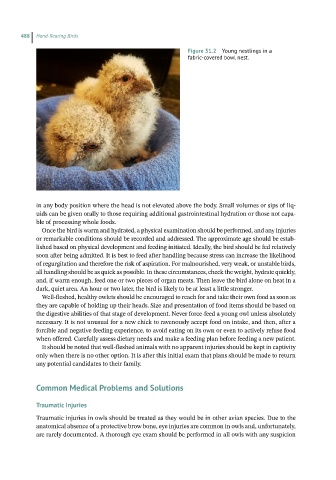Page 492 - Hand rearing birds second
P. 492
488 Hand-Rearing Birds
Figure31.2 Young nestlings in a
fabric-covered bowl nest.
in any body position where the head is not elevated above the body. Small volumes or sips of liq-
uids can be given orally to those requiring additional gastrointestinal hydration or those not capa-
ble of processing whole foods.
Once the bird is warm and hydrated, a physical examination should be performed, and any injuries
or remarkable conditions should be recorded and addressed. The approximate age should be estab-
lished based on physical development and feeding initiated. Ideally, the bird should be fed relatively
soon after being admitted. It is best to feed after handling because stress can increase the likelihood
of regurgitation and therefore the risk of aspiration. For malnourished, very weak, or unstable birds,
all handling should be as quick as possible. In these circumstances, check the weight, hydrate quickly,
and, if warm enough, feed one or two pieces of organ meats. Then leave the bird alone on heat in a
dark, quiet area. An hour or two later, the bird is likely to be at least a little stronger.
Well‐fleshed, healthy owlets should be encouraged to reach for and take their own food as soon as
they are capable of holding up their heads. Size and presentation of food items should be based on
the digestive abilities of that stage of development. Never force‐feed a young owl unless absolutely
necessary. It is not unusual for a new chick to ravenously accept food on intake, and then, after a
forcible and negative feeding experience, to avoid eating on its own or even to actively refuse food
when offered. Carefully assess dietary needs and make a feeding plan before feeding a new patient.
It should be noted that well‐fleshed animals with no apparent injuries should be kept in captivity
only when there is no other option. It is after this initial exam that plans should be made to return
any potential candidates to their family.
CommonMedicalProblemsand Solutions
TraumaticInjuries
Traumatic injuries in owls should be treated as they would be in other avian species. Due to the
anatomical absence of a protective brow bone, eye injuries are common in owls and, unfortunately,
are rarely documented. A thorough eye exam should be performed in all owls with any suspicion

